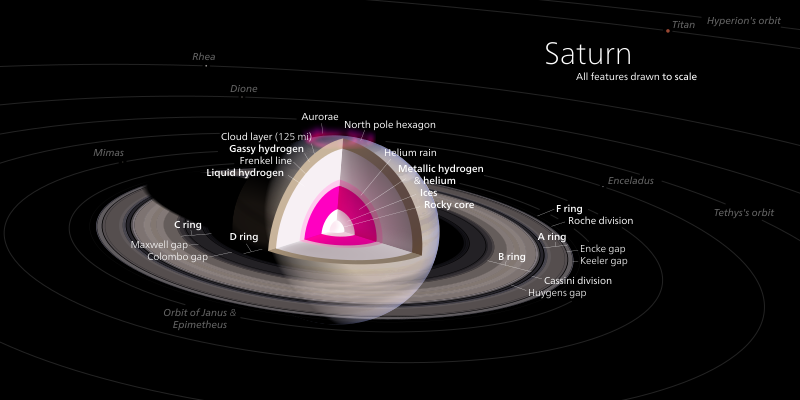11.3: Saturn
( \newcommand{\kernel}{\mathrm{null}\,}\)
.jpg?revision=1) Saturn from Cassini Orbiter.
Saturn from Cassini Orbiter.
https:/commons.wikimedia.org/wiki/File:Saturn_from_Cassini_Orbiter_(2004-10-06).jpg;
Saturn is somewhat colder than Jupiter. Compared to Jupiter, its atmosphere is thicker and its bands are fainter. Saturn’s bands are fainter and less prominent than those of Jupiter. Saturn’s atmosphere is much like Jupiter’s in composition, but its pressure is lower.
The composition of Saturn is as follows:
- ~96% Hydrogen (H2)
- ~3% Helium
- ~0.4% Methane
- ~0.01% Ammonia
- ~0.01% Hydrogen deuteride (HD)
- 0.0007% Ethane.
- Ices in Saturn include: Ammonia, water, ammonium, hydrosulfide(NH4SH).
Saturn has three cloud layers, which are deeper inside Saturn compared to Jupiter’s. The ammonia ice layer is approximately 50-100 km below the top of the troposphere. The ammonia hydrosulfide ice layer is around 200 km below the top of the troposphere. Finally, the water ice layer is approximately 250-300 km below the troposphere. A layer of haze exists above the ammonia ice layer, obscure much of what is below. Cloud layers on Saturn are thicker than Jupiter’s so we see only the top layer.
Like Jupiter, Saturn also has large storms. One storm was observed by the Cassini spacecraft in 2011, though it faded after several months.
Like Earth and Venus, Saturn has enormous polar vortices that resemble huge storm systems. One peculiar feature of these vortices is that the southern vortex forms a hexagon. Compared to Jupiter, Saturn's atmosphere has less lightning and less auroral activity.
Like Jupiter, Saturn radiates more energy that receives from the Sun, about 2-3 times as much. Rather than from heat of from the interior, Saturn’s excess energy probably comes from differentiation from helium rain that falls in its lower atmosphere.
Saturn’s interior also consists of liquid and metallic hydrogen layers, though its metallic hydrogen layer is not as deep as Jupiter’s due to its smaller size. Scientists also believe Saturn has a solid core made of rock and ices that may be 9-20 Earth masses in size.
 Saturn and its interior
Saturn and its interior
Saturn, like all the Jovian planets, rotates faster at the equator than at the poles. It also has a strong magnetic field.



